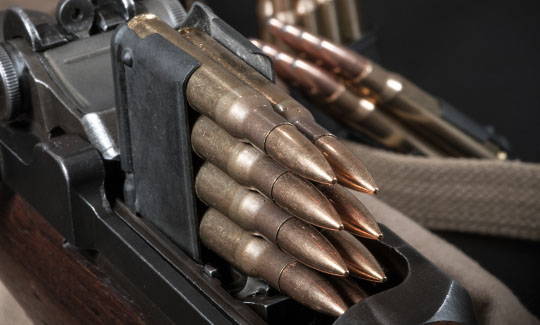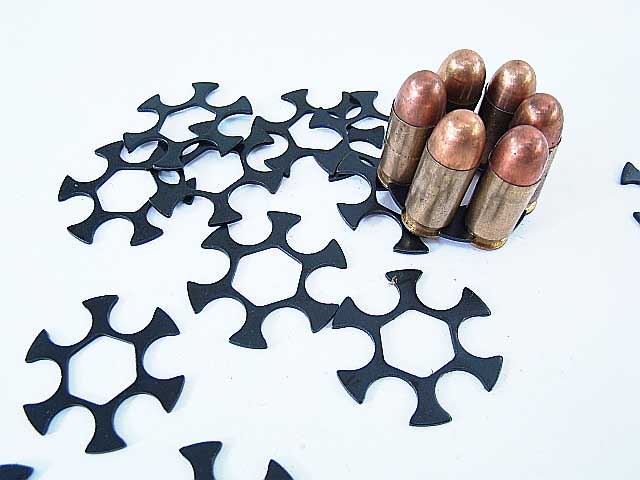If you're a gun enthusiast, you may have heard the terms "clip" and "magazine" used interchangeably to describe the feeding mechanism in firearms. However, these terms actually refer to different mechanisms. A clip is a device used to hold ammunition together in a single unit, while a magazine is a container that holds cartridges under spring pressure for insertion into the firearm's chamber.

Unfortunately, the confusion surrounding the terms "clip vs magazine" can make it difficult to understand the differences between these two feeding mechanisms. The common misconceptions surrounding these terms can lead to confusion among gun owners, making it challenging to select the appropriate feeding mechanism for their firearms. That's why we've created this guide to clear up the confusion surrounding clips and magazines, providing a comprehensive explanation of their differences, usage, and advantages and disadvantages.
Whether you're wondering what is a clip for a gun, which guns use clips, or the clip and magazine difference, this guide will provide you with the information you need to make informed decisions about your firearms.
Table Of Contents
I. What is a clip for a gun?
A. What Is A Clip?

A clip is a device used to hold cartridges together in a single unit, designed to quickly load a firearm with ammunition.
The main purpose of a clip is to make it easy for gun owners to reload their firearms quickly, especially in combat or hunting situations. Typically made of metal or plastic, clips are still used in some modern firearms, but they have largely been replaced by magazines. Even though clips have been around for decades and are still in use today, their purpose and definition are often confused with magazines, leading to misunderstandings among gun enthusiasts.
Clips are a popular option for storing and loading ammunition in firearms, and they come in various shapes and sizes. They can be used in different types of firearms like rifles, pistols, and revolvers. The three main types of clips that are widely used by gun owners are stripper clips, en bloc clips, and moon clips.
B. Types Of Clips
There are several different types of clips that serve various purposes, including Stripper Clip, En Bloc Clip and Moon Clip. Each type of clip has its own unique design.
1. Stripper Clip
Stripper clips are typically used in military-style rifles and semi-automatic pistols. These clips are made of a thin strip of metal, usually brass or steel, with ammunition cartridges lined up in a row along the length of the clip. The cartridges are held in place by a small lip at the base of the clip.
The clip is inserted into the firearm's internal magazine, which pushes the cartridges up into the chamber for firing. The clip is then ejected from the firearm, and the next clip can be inserted.
Stripper clips are designed to speed up the reloading process for firearms with internal magazines.
2. En Bloc Clip
En bloc clips are commonly utilized in firearms like the M1 Garand rifle. They have a rectangular shape and can store multiple rounds of ammunition. These clips are inserted directly into the firearm's magazine well along with the ammunition. When the rounds are fired, the clip is ejected automatically from the rifle.
En bloc clips are favored by collectors and vintage firearms enthusiasts due to their association with historically significant firearms.
3. Moon Clip
Moon clips are primarily employed in revolvers and are highly popular among competitive shooters who require swift and efficient reloading of their revolvers. These clips have a circular shape and can hold multiple cartridges securely around the perimeter of the circle. Made of metal, moon clips are designed to keep the cartridges in place until they are needed.
To reload the revolver, gun owners can effortlessly insert the moon clip into the cylinder, holding the cartridges in place until they are ready to be fired. Moon clips are frequently used in revolvers chambered in calibers like .45 ACP and 9mm.
If you live in the South you must know how hard it can be to wear a holster on a daily basis, especially on a hot summer day. If you're finding an easy way to solve this, get yourself a Summer Gun Clip! Stop dressing around your holster, and wear the clothes you want while confidently, securely and discreetly carrying your pistol with Summer Gun Clip.
II. What is a magazine for a gun?
A. What Is A Magazine?

A magazine is a device used for storing and feeding ammunition into firearms. Unlike clips, magazines are self-contained and can be detached from the firearm for reloading. They typically consist of a metal or plastic box with a spring mechanism that pushes the ammunition into the firearm's chamber.
The purpose of a magazine is to provide a convenient and efficient way to feed ammunition into the firearm, allowing for quick and easy reloading during combat or target shooting.
Magazines come in various sizes and shapes, depending on the type of firearm they are designed for, and can hold anywhere from a few rounds to dozens of rounds of ammunition. They are a crucial component of any firearm and have greatly improved the efficiency and effectiveness of firearms since their invention.
B. Types Of Magazines
There are several types of magazines available for pistols, each designed for specific purposes and preferences of the shooter. Here is a brief overview of some of the most common types:
1. Box Magazines

Box magazines are the most common type of magazine, and they are often used in rifles.
They are called box magazines because they have a rectangular shape, and they are typically detachable. Box magazines can hold a varying number of rounds, depending on the firearm, and they are loaded by inserting rounds into the top of the magazine. When the magazine is empty, it can be removed and replaced with a full magazine.
2. Detachable Magazines
Detachable magazines are similar to box magazines, but they can be removed from the firearm without having to remove the rounds. This makes it easier to reload the firearm quickly and is a popular choice among shooters who need to reload frequently. Detachable magazines can be found in rifles, shotguns, and pistols.
3. Internal Magazines

These types of magazines are loaded by inserting ammunition directly into a port located on the side of the firearm. Compared to box or detachable magazines, they have a lower capacity, but they are more dependable and long-lasting due to their incorporation into the firearm's structure.
4. Tubular Magazines

They are often used in lever-action rifles and shotguns, and they have a long, tubular shape that runs under the barrel of the firearm. Rounds are loaded into the magazine by sliding them through a port on the side of the magazine. Tubular magazines typically hold fewer rounds than a box or detachable magazines, but they are a popular choice among hunters and sportsmen who prefer the classic look and feel of lever-action firearms.
III. Clip vs. Magazine: What's the Difference?
The table above outlines the key differences between clips and magazines. Clips are typically thin and strip-shaped and are used to feed rounds directly into a gun's internal magazine. They generally have a lower capacity than magazines and require manual reloading after the rounds have been fired. Types of clips include stripper clips, en bloc clips, and moon clips, and they are commonly used in historical firearms and some modern firearms.
On the other hand, magazines are rectangular or box-shaped and can be inserted into the gun to store and feed rounds. They generally have a higher capacity than clips and can be quickly and easily swapped out for a fresh one, allowing for faster reloading. Types of magazines include box magazines, detachable magazines, internal magazines, and tubular magazines, and they are commonly used in a wide variety of firearms, including pistols, rifles, and shotguns.
The Dinosaur 3-in-1 Holster is a practical and convenient choice for carrying firearms and accessories. It features two gun holsters, pockets for magazines, and a zipper pocket for cash or cards. This holster is durable and versatile, making it a great choice for anyone who prioritizes firearm safety and security.
IV. Guns That Use Clips vs. Guns That Use Magazines
A. Guns That Employ Clips: A List of Examples
1. M1 Garand Rifle:

Pros:
En bloc clip design allows for quick and easy reloading.
Large ammunition capacity.
Well-balanced and accurate.
Heavy and bulky, making it less maneuverable.
Loud and can generate a lot of recoils.
Can be difficult to maintain and clean.
2. Mauser C96 Pistol:

Pros:
Compact and lightweight.
Reliable and durable.
Large ammunition capacity.
Cons:
Slow reloading due to the need for stripper clips.
Can be difficult to control due to its powerful recoil.
Outdated design, with limited modern features.
3. Mosin-Nagant Rifle:

Pros:
Simple and rugged design.
Affordable and widely available.
High ammunition capacity.
Cons:
Heavy and bulky, making it less maneuverable.
Loud and generates a lot of recoils.
Poor accuracy beyond short ranges.
4. SKS Rifle:

Pros:
Quick and easy reloading with detachable stripper clips.
Lightweight and compact design.
Affordable and widely available.
Cons:
Limited ammunition capacity compared to other rifles.
Can be difficult to control due to its powerful recoil.
Not as accurate as other rifles.
5. Mannlicher-Carcano Rifle:
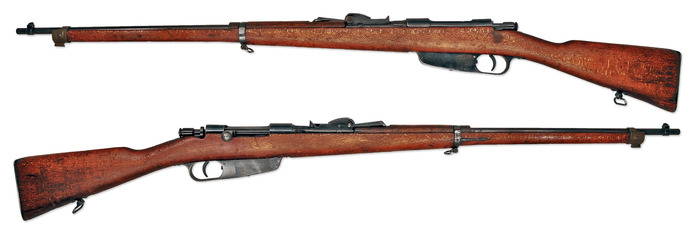
Pros:
Quick and easy reloading with en bloc clips.
Accurate and reliable.
Lightweight and easy to carry.
Cons:
Limited ammunition capacity compared to other rifles.
Outdated design with limited modern features.
Not as widely available or popular as other rifles.
B. Guns That Employ Magazines: A List of Examples
1. Glock 19:
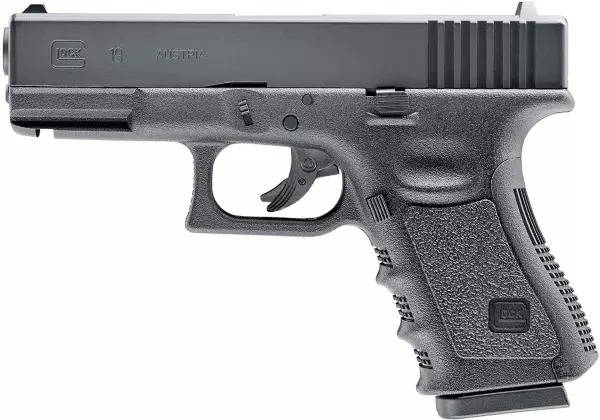
Pros:
Easy to use and maintain
Large magazine capacity
Comfortable grip
Popular and widely available
Cons:
Limited customization options
May not fit well in smaller hands
2. AR-15:

Pros:
Highly customizable
Large variety of compatible accessories and parts
Light and maneuverable
High magazine capacity
Cons:
Can be expensive to build or purchase
Heavier recoil compared to some other rifles
3. Remington 700:

Pros:
Accurate and reliable
Can be customized with various aftermarket parts
Available in a variety of calibers
Cons:
More difficult to operate compared to semi-automatic rifles
Limited magazine capacity
4. Henry Lever Action:
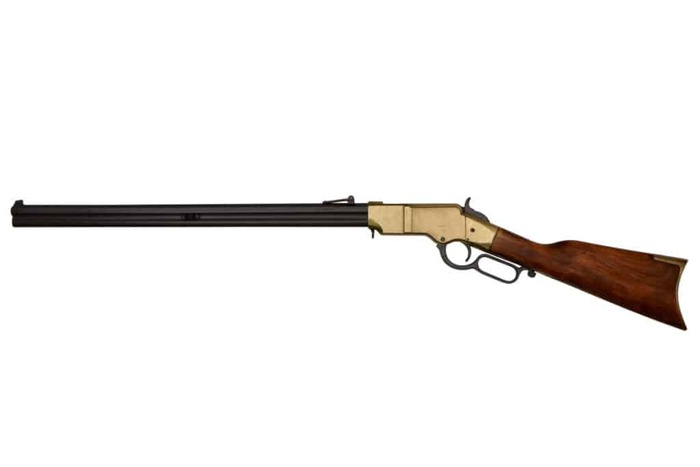
Pros:
Classic design and aesthetics
Smooth action and operation
Available in a variety of calibers
Lightweight and maneuverable
Cons:
Limited magazine capacity
Loading the magazine can be slow and tedious
5. Smith & Wesson M&P:

Pros:
Comfortable and ergonomic grip
Modular design allows for customization
Available in a variety of calibers
High magazine capacity
Cons:
May not fit well in smaller hands
Slide lock can be difficult to operate for some users.
V. Clip vs. Magazine: Which Is Better for Your Pistol?
A. Factors to consider when choosing between A Clip and A Magazine
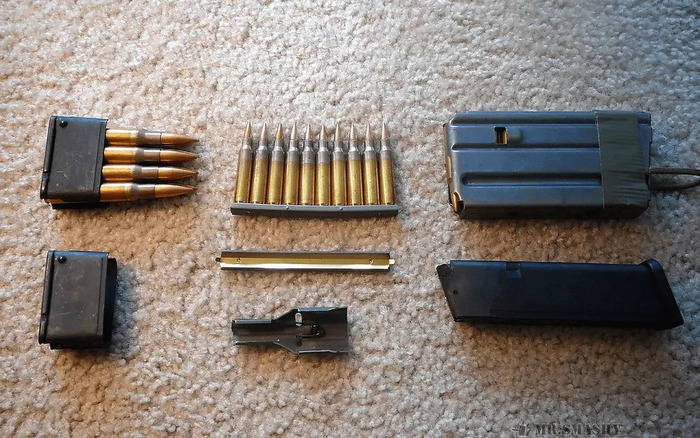
When deciding between a clip and a magazine for your firearm, there are several factors to consider. Here are a few:
Firearm type: Some firearms, like revolvers, can only use clips, while others, like the AR-15, can only use magazines.
Ammunition capacity: Magazines typically hold more rounds than clips, so if you need a higher ammunition capacity, a magazine may be a better choice.
Reloading speed: Clips can often be inserted faster than magazines, but magazines can be swapped out more quickly when empty.
Convenience: Magazines are often easier to load and handle than clips, which can be finicky and require more manipulation.
Availability: Depending on your firearm and ammunition type, clips or magazines may be more readily available and easier to find.
Ultimately, the decision between a clip and a magazine will depend on your specific firearm, shooting needs, and personal preferences.
B. Which feeding mechanism is best for different shooting styles?

There is no one-size-fits-all answer to which feeding mechanism is best for different shooting styles, as it largely depends on personal preference and the intended use of the firearm. However, certain shooting styles may lend themselves better to certain feeding mechanisms.
For example:
Rapid-fire shooting: A detachable magazine may be preferred as it allows for quick and easy reloading, which is important in situations where speed is a priority.
Precision shooting: A firearm with an internal magazine may be preferred as it tends to be more rigid and can provide a more stable shooting platform, which is important for accuracy
Hunting: A firearm with a tubular magazine may be preferred as it tends to be quieter and less likely to get snagged on vegetation, which can be important when trying to remain stealthy in the field.
Ultimately, the best feeding mechanism for a particular shooting style will depend on a variety of factors, including the shooter's personal preferences, the intended use of the firearm, and the specific characteristics of the firearm itself.
c. How to properly load and unload each type of feeding mechanism?
1. Loading and Unloading a Clip

1.1. Stripper Clip
Loading:
Insert the stripper clip into the guide on the top of the firearm's receiver.
Push down on the cartridges to slide them off the clip and into the magazine.
Remove the stripper clip.
Unloading:
Remove the magazine from the firearm.
Use the magazine follower to push the cartridges out of the magazine.
Discard the stripper clip.
1.2. En bloc clip
Loading:
Insert rounds into the clip from the top.
Insert the clip into the firearm's magazine well.
The clip will be ejected from the firearm.
Unloading:
Press the clip release button or lever.
The clip will be ejected from the firearm.
Note: En bloc clips are not designed to be reused.
1.3. Moon clip
Loading:
Place the cartridges into the moon clip, with the bullet end facing outward and the rim of the cartridge facing inward.
Press the cartridges firmly into place in the moon clip, ensuring that they are all fully seated.
Insert the moon clip into the cylinder of the revolver until it clicks into place.
Unloading:
Open the cylinder of the revolver and push out the spent casings and moon clip.
Use a tool to push the cartridges out of the moon clip.
1. Loading and Unloading a MaGazine

2.1. Box Magazine:
Loading:
Open the bolt or slide of the firearm to access the magazine well.
Insert the magazine into the magazine well, ensuring that it is fully seated and locked in place.
Load rounds into the magazine by pushing them down into the magazine with your thumb or a loading tool. The capacity of the magazine will depend on the firearm model and magazine size.
Close the bolt or slide to chamber a round and make the firearm ready to fire.
Unloading:
Remove it from the magazine well and use your thumb or a tool to push the rounds out of the magazine.
2.2. Detachable Magazine:
Loading:
Press the magazine release button or lever to release the magazine from the firearm.
Insert a loaded magazine into the magazine well until it clicks into place.
Pull the bolt or slide back to chamber a round and make the firearm ready to fire.
Unloading:
Press the magazine release button or lever to remove the magazine from the firearm and then use your thumb or a tool to push the rounds out of the magazine.
2.3. Internal Magazine:
Loading:
Open the bolt or slide of the firearm to access the magazine.
Load rounds into the magazine through the top of the receiver, either one at a time or by using a loading tool.
Close the bolt or slide to chamber a round and make the firearm ready to fire.
Unloading:
Open the bolt or slide and manually remove each round from the magazine.
2.4. Tubular Magazine:
Loading:
Open the firearm's loading gate or remove the magazine tube cap to access the magazine.
Load rounds into the magazine through the muzzle end of the magazine tube, either one at a time or by using a loading tool.
Replace the loading gate or magazine tube cap and cycle the action to chamber a round and make the firearm ready to fire.
Unloading:
Open the loading gate or remove the magazine tube cap and manually remove each round from the magazine.
VI. FAQs
1. Are gun clips and magazines the same?
No, gun clips and magazines are not the same. They are two different types of feeding mechanisms that hold and feed ammunition into firearms.
2. Does a Glock have a magazine or a clip?
A Glock uses a magazine, not a clip. The magazine is inserted into the grip of the firearm and holds the ammunition, while the clip is a separate device used to hold and feed ammunition into a firearm with a fixed internal magazine.
3. Does an AR-15 have a clip or magazine?
An AR-15 rifle uses a detachable box magazine. It does not use a clip.
4. Can you shoot Glock without the clip in?
No, a Glock cannot be fired without a magazine (clip) inserted. The magazine is an essential part of the firearm's operation, as it feeds the ammunition into the chamber for firing. Without a magazine in place, the Glock's slide will not fully close, and the firing pin will not engage the cartridge. Therefore, it is necessary to have a loaded magazine in the Glock to use it properly.
5. How many rounds is a 9mm clip?
It depends on the specific type of clip being used. However, it is more common to refer to the detachable ammunition feeding device used by a Glock or other semi-automatic handgun as a magazine rather than a clip. The standard magazine capacity for a Glock 9mm handgun can range from 10 to 33 rounds, depending on the model and the type of magazine being used.
VII. Final Thoughts
In conclusion, understanding the differences between clips and magazines is crucial for any firearm owner. While both feeding mechanisms serve the same purpose of holding and feeding ammunition, they have significant differences that can impact performance, reliability, and overall shooting experience.
Choosing the right feeding mechanism for your firearm depends on several factors, including your shooting style, firearm type, and personal preference. With proper knowledge of loading and unloading procedures, you can ensure the safe and efficient use of your firearm.
Whether you prefer a clip or a magazine, it's essential to practice responsible firearm ownership and always prioritize safety.
Recent Articles:
From Range to Tactical: The Best AR Pistols For Every Purpose
Single vs Double Magazine Showdown: Which One Wins For Reliability and Capacity ?
Mastering Barrel Measurement: Understanding The Importance of Accurate Barrel Lengths
RIP Round: The Ultimate Ammo For Tactical Shooting
Your Complete Guide To Carrying A Firearm in A Bank
A Comprehensive Guide on How to Clean Your AR-15 Like A Pro
Are you having fun reading with Dinosaurized? Here's a little gift for better shopping experience~
Enter this 15% Discount code: "GundiscussionD15" at Checkout now~


